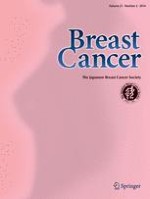Erschienen in:

01.03.2014 | Original Article
Computed tomographic lymphography predicts the difficulty of sentinel lymph node biopsy with dye
verfasst von:
Kazunori Yokohata, Masami Hattori, Takaaki Fujimoto, Nobuhito Chikazawa, Ryo Maeyama, Naoki Yamanaka, Hideo Kuroki, Nobuhiko Sasaki, Nobuhisa Kameoka, Naoyuki Matoba
Erschienen in:
Breast Cancer
|
Ausgabe 2/2014
Einloggen, um Zugang zu erhalten
Abstract
Background
Sentinel lymph node biopsy (SLNB) has been a method of choice for treating breast cancer. Computed tomographic lymphography (CT-LG) provides a view of the sentinel lymph node (SLN) with the detailed lymphatic anatomy preoperatively, and the SLN is easily identified during SLNB. In this article, we examined the usefulness of CT-LG to predict the difficulty of SLNB with the dye method.
Methods
A total of 41 consecutive patients who underwent CT-LG were enrolled in this study. Each CT-LG image was reviewed by one of our co-authors. The images of lymph vessels (LVs) and SLNs were assorted into three categories: not visualized, poorly visualized, and well visualized. The time engaged in SLNB with the dye method was recorded in 30 patients.
Results
The time engaged in SLNB between two groups was compared: patients in whom both the SLN and LVs were well visualized (n = 16) and the remaining patients (n = 14). The former required a significantly shorter time than the latter (12.6 ± 4.1 vs. 17.6 ± 6.7 min, respectively; p = 0.025 by Mann-Whitney U test).
Conclusions
Our study clearly demonstrates that the CT-LG findings of well-visualized LVs and SLNs predict the easy access to the stained LVs and SLNs. This information provides several advantages, including the fact that an easy SLNB case can be selected for a doctor with little experience in SLNB, and the volume of dye and/or length of massage can be changed for better identification of stained LVs and SLNs during SLNB.